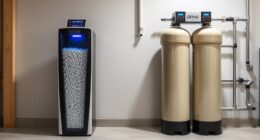Salt-based softeners come with hidden costs like ongoing salt purchases, water waste during regeneration, and frequent resin tank replacements, which can add up unexpectedly. They also consume more energy and may require costly repairs or upgrades over time. Salt-free systems might have higher upfront costs but lower maintenance and environmental impact, saving you money long-term. To avoid surprises, understanding these hidden expenses can help you make smarter choices—explore further to find out how.
Key Takeaways
- Salt-based systems incur hidden costs from frequent resin replacement, water waste, and unpredictable repair expenses.
- Salt-free systems have higher upfront costs but lower ongoing expenses due to durable, corrosion-resistant components.
- Water waste and salt discharge in salt systems can lead to environmental fines and increased water bills.
- Proper maintenance and system design help prevent costly breakdowns and extend the lifespan of both system types.
- Choosing salt-free or salt alternative systems reduces hidden environmental and operational costs over time.
Ongoing Salt and Water Expenses
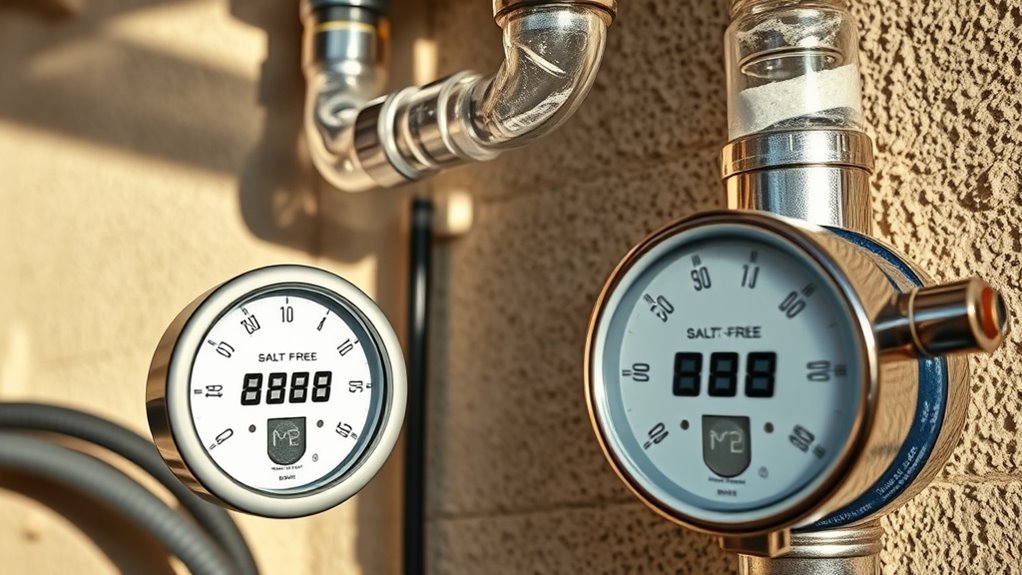
When choosing a water softening system, it’s important to take into account the ongoing costs of salt and water. Salt-based systems require regular salt additions, which can add up over time, especially if you need frequent refills. Additionally, these systems produce water waste through salt discharge during regeneration cycles, leading to higher water bills and environmental concerns. You’ll need to monitor salt levels carefully to maintain efficiency and avoid overuse. The amount of water wasted varies depending on the system’s size and usage patterns, but it’s a consistent ongoing expense. Being aware of vetted products and their efficiencies can help you select a system that minimizes waste. Keeping track of these costs helps you plan for the long-term financial and environmental impacts of your water softening choice. This awareness ensures you select a system that balances effectiveness with ongoing expenses.
Hidden Environmental Costs of Salt-Based Systems
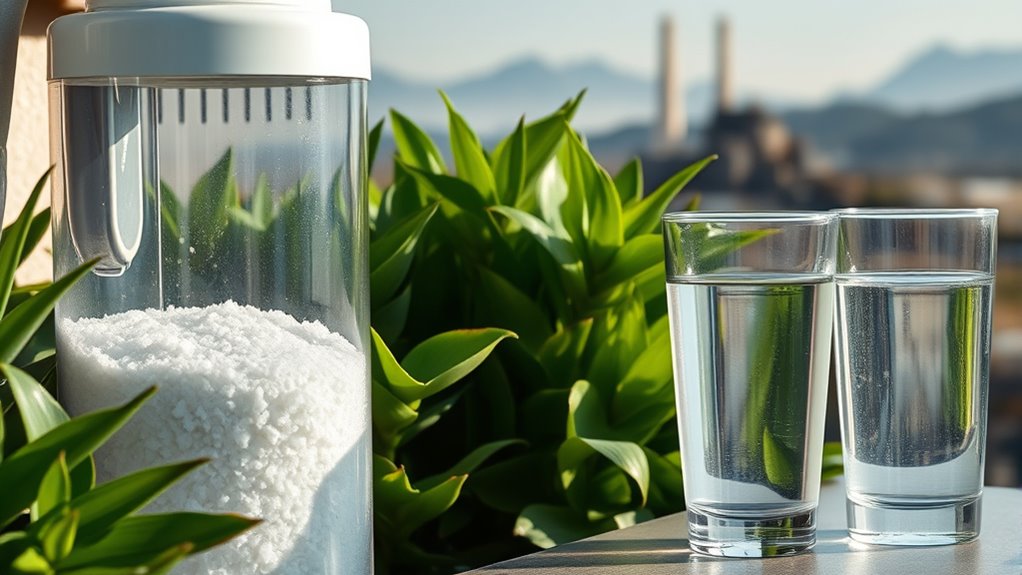
Salt-based water softening systems often carry hidden environmental costs that go beyond the immediate expenses. The environmental impact of these systems extends to the ecological footprint they create. When salt is added to softening tanks, excess brine is discharged into local water sources, altering natural ecosystems. This process can harm aquatic life, disrupt water chemistry, and contribute to increased salinity levels in rivers and lakes. Additionally, the production and transportation of salt consume energy and resources, further increasing the ecological footprint. Over time, these hidden costs can lead to broader environmental degradation, impacting biodiversity and water quality. By choosing salt-free alternatives, you help reduce these negative effects and lessen your overall environmental impact. Understanding environmental impact is essential for making informed decisions about water treatment options.
Maintenance and Replacement of Resin Tanks
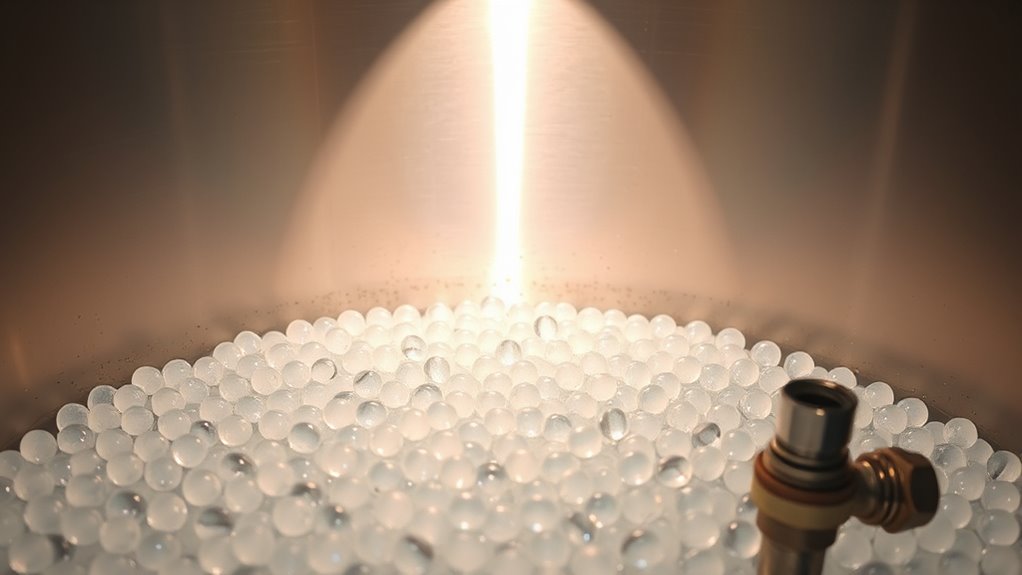
Your resin tank needs attention over time, and understanding its lifespan helps you plan for replacement costs. Resin typically lasts several years before it needs changing, but this varies based on usage and water quality. Knowing these details guarantees you stay ahead of potential maintenance expenses. Regular GMC tuning can also help optimize system performance and extend the lifespan of your resin tank.
Resin Tank Lifespan
Resin tanks in water softening systems typically last between 10 and 15 years with proper maintenance. The lifespan durability of your resin tank depends on regular upkeep and water quality. Over time, resin beads can become fouled or exhausted, reducing their effectiveness, but a well-maintained tank can reach the upper end of that range. Proper cleaning and avoiding chemical damage help extend your resin tank’s longevity. Keep an eye on system performance, as declining efficiency may signal the need for inspection. Investing in quality resin tanks and following manufacturer guidelines can maximize your tank’s lifespan. Additionally, understanding how risk assessment and maintenance practices impact resin tank durability helps you plan better for future replacements, saving you money and ensuring consistent soft water.
Resin Replacement Costs
Maintaining your water softening system includes monitoring the condition of the resin tank, as resin replacement is a key part of ongoing costs. Over time, the resin undergoes resin renewal, reducing its effectiveness at softening water. When this happens, you’ll need to replace or upgrade the resin. Proper resin recycling can help extend the lifespan of your system and reduce waste. The cost of resin replacement varies depending on the system size and resin quality, but it’s an unavoidable expense for salt-based softeners. Regular maintenance and timely resin renewal can prevent costly repairs and ensure your system operates efficiently. By understanding resin replacement costs and exploring options like resin recycling, you can better manage your softening system’s long-term expenses. Additionally, cost-of-ownership math can help you evaluate these expenses in relation to other system components to make informed decisions.
Energy Consumption and Efficiency Concerns
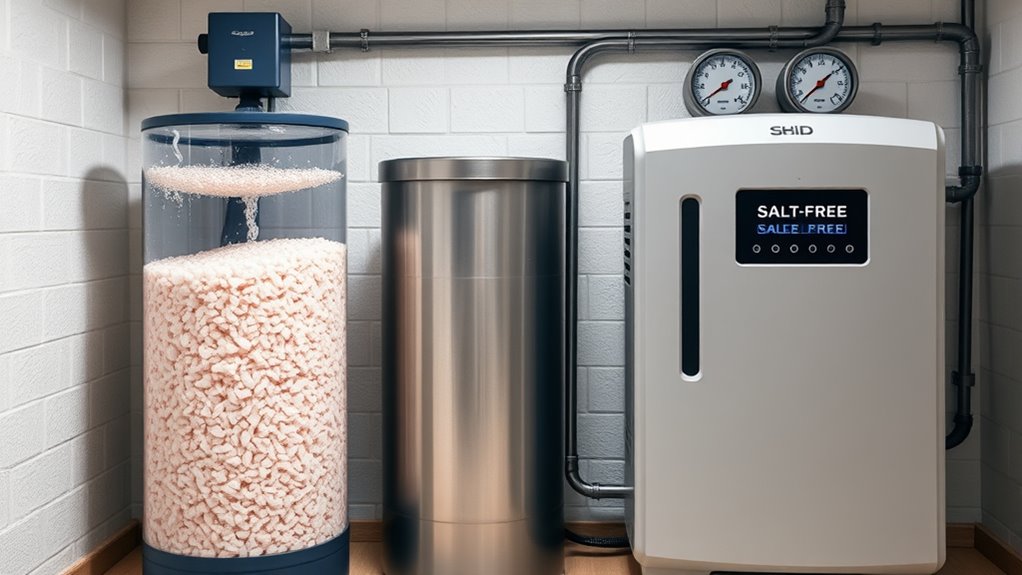
While salt-based water softeners are effective at removing hardness minerals, they often consume more energy than salt-free systems. These systems require power to operate the control valves, regeneration cycles, and the brine tank. As a result, their energy efficiency can be lower, leading to higher power consumption over time. Salt-free systems, on the other hand, typically use minimal electricity, mainly for flow regulation or electronic controls, which reduces overall energy use. If you’re concerned about energy costs, a salt-free softener offers a more efficient alternative. Keep in mind that frequent regeneration cycles in salt-based systems can increase power consumption considerably, impacting your energy bills. Choosing a system with better energy efficiency can save you money and reduce your environmental footprint.
Hidden Costs of Salt-Free System Components
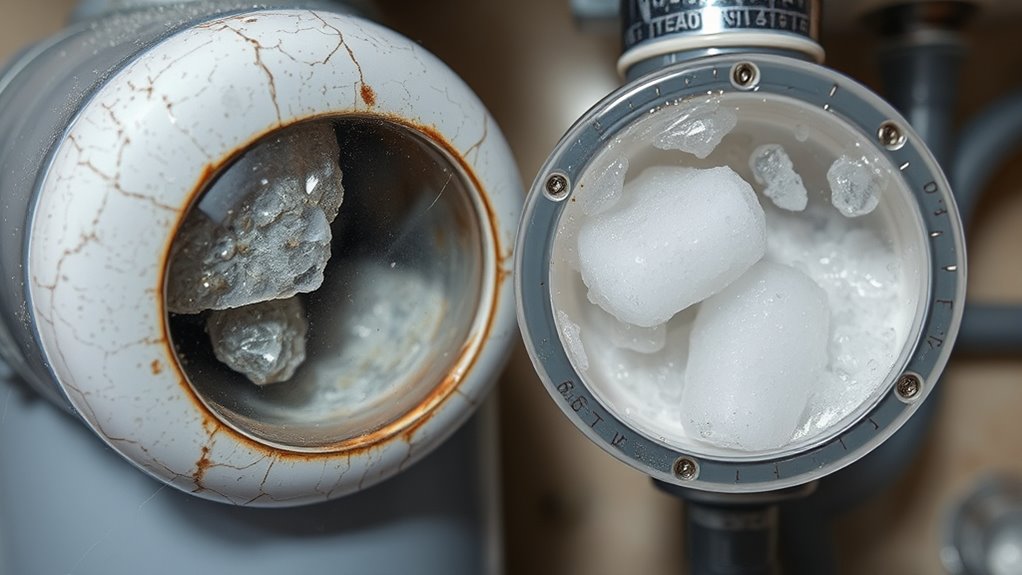
You might find that salt-free systems come with hidden costs related to component replacement over time. These parts can wear out or become less effective, leading to unexpected expenses. Additionally, compatibility issues with your existing plumbing or appliances can add to your overall costs. Monitoring the aura technology of your system can help identify early signs of component deterioration before costly repairs are needed.
Component Replacement Expenses
Although salt-free water softeners often seem like a low-maintenance option, their components can incur significant replacement costs over time. The durability of key parts varies, and some may need frequent repairs or replacement, especially if warranty coverage is limited. You might face unexpected expenses for parts like the conditioning media or flow restrictors, which can wear out faster than expected. Regular inspection and understanding component longevity can help you avoid unexpected costs and ensure your system functions optimally. Component durability is a crucial factor in planning for potential expenses. Understanding the longevity of salt-free system parts helps you plan for potential costs. Investing in high-quality components with better durability and extensive warranty coverage can reduce your overall replacement expenses.
System Compatibility Challenges
Salt-free water softeners often face compatibility issues that can lead to unexpected costs. These challenges stem from system integration problems, where the softener may not work seamlessly with your existing plumbing or household appliances. If the components aren’t compatible, you might need additional adapters, modifications, or even replacement parts, increasing your expenses. Additionally, proper user training is essential to ensure you operate the system correctly and avoid damage or inefficiency. Without adequate training, you risk misuse that can lead to costly repairs or early system failure. To minimize these hidden costs, research compatibility before installation and invest time in learning how to properly maintain and operate your salt-free system. This proactive approach can save you money and frustration down the line. Understanding Self Watering Plant Pots can serve as a helpful analogy when considering system compatibility, as both require proper design and integration to function effectively.
Long-Term Durability and Replacement Expenses
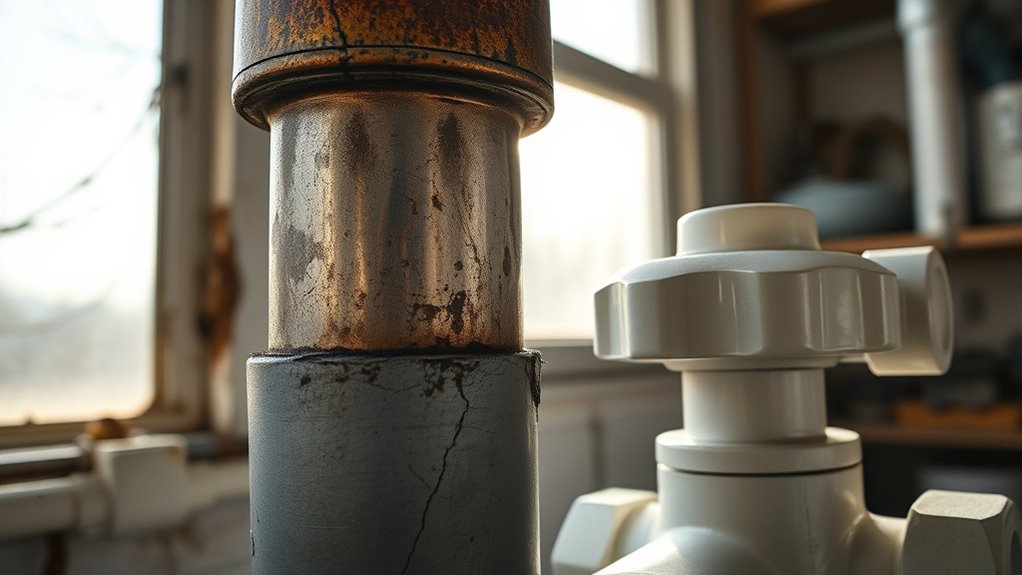
When contemplating the long-term durability of water softening systems, salt-based units tend to require more frequent replacements of components like resin tanks and brine valves due to wear and corrosion. This can lead to higher ongoing expenses and maintenance hassles. Over time, the resin tank’s durability diminishes as mineral buildup and corrosion weaken materials, requiring replacement. Salt-free systems generally offer better salt free component longevity, reducing the need for parts replacement. Incorporating self-improvement techniques such as goal setting and mindfulness can also help homeowners stay proactive in maintaining their systems and managing costs.
Key points to consider:
- Resin tanks in salt-based units often need replacement sooner due to corrosion
- Salt-free systems typically feature more durable, corrosion-resistant components
- Extended component lifespan lowers long-term replacement costs and system downtime
Cost Implications of System Upgrades and Repairs

Upgrading or repairing water softening systems can substantially impact your long-term costs, especially if you choose a salt-based unit. Salt systems often require more frequent repairs, which affects repair frequency analysis and overall system upgrade affordability. These repairs can lead to unexpected expenses if not planned for. When considering upgrades, evaluate whether the system’s design allows for easier repairs or upgrades to reduce costs.
| Repair Frequency | Upgrade Cost | Long-term Expense |
|---|---|---|
| Higher in salt units | Often higher | Increased over time |
| Lower in salt-free systems | Usually lower | More predictable |
| Maintenance costs vary | Depends on system | Affects total investment |
Practical Tips to Minimize Hidden Expenses

To keep long-term costs manageable, it’s important to identify and address hidden expenses associated with water softening systems. One practical tip is to choose reputable water softener branding that guarantees quality and support, reducing repair costs. Next, consider salt alternative technology options, which often require less maintenance and lower ongoing expenses. Regularly inspecting your system can prevent costly breakdowns and ensure ideal performance. Additionally, researching systems that integrate salt-free or salt alternative technology can help you avoid ongoing salt costs and related issues. By being proactive, you minimize hidden expenses, extend your system’s lifespan, and save money over time. Prioritize quality, maintenance, and technology choices to keep your water softening costs predictable and affordable.
Frequently Asked Questions
How Do Salt-Based Systems Impact Local Water Quality Long-Term?
Salt-based systems can negatively impact your local water quality long-term by increasing sodium levels, which may harm aquatic life and disrupt ecosystems. They also pose environmental risks through salt runoff, contaminating water sources. Additionally, these systems often require more water for regeneration, reducing overall water conservation efforts. By understanding these impacts, you can choose softer solutions that protect water quality and support sustainable water use in your community.
Are There Health Concerns Related to Salt Residue in Softened Water?
Like a cautious sailor wary of hidden reefs, you should know that salt residue in softened water can pose health concerns, especially for those on low-sodium diets. While most people tolerate it well, excessive salt residue may lead to increased sodium intake, impacting blood pressure and heart health. To avoid this, consider regular maintenance or salt-free systems, ensuring your water remains safe without unnecessary health risks.
What Are the Hidden Costs of System Downtime or Failure?
System downtime or failure can cost you considerably through unexpected shutdowns that require costly system repairs. When your softening system fails, you might face water damage, appliance malfunctions, or increased utility bills. These unexpected issues disrupt your daily routine and lead to unplanned expenses. Regular maintenance helps prevent costly repairs, but staying vigilant for signs of system failure ensures you can address problems early, avoiding prolonged downtime and costly repairs.
Can Maintenance Costs Vary Significantly Between Brands?
You’ll find that maintenance costs can vary considerably between brands, often due to differences in brand reliability and maintenance frequency. When a brand is less reliable, you might face more frequent repairs or replacements, increasing costs over time. Conversely, choosing a reputable brand with proven durability can reduce maintenance needs and expenses. So, it pays to compare brands carefully, considering both reliability and how often maintenance is recommended.
How Do Salt-Free Systems Affect Plumbing Lifespan?
Salt-free systems help extend your plumbing lifespan by reducing mineral buildup and plumbing corrosion. Unlike salt-based softeners that can cause mineral deposits to accumulate, salt-free options prevent these issues, decreasing the risk of damage over time. You’ll notice fewer clogs and leaks, which ultimately saves you money on repairs. Regular maintenance and choosing the right system guarantee your pipes stay in good condition longer, avoiding costly replacements down the line.
Conclusion
While salt-free systems may seem pricier upfront, they save you money on ongoing expenses and environmental impact in the long run. Don’t let the initial cost scare you—think of it as an investment in durability and efficiency. You can avoid hidden costs by choosing quality components and regular maintenance. Ultimately, making an informed choice now guarantees you won’t face costly repairs or replacements later—saving you time, money, and peace of mind.








